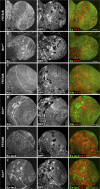Differential control of Yorkie activity by LKB1/AMPK and the Hippo/Warts cascade in the central nervous system
- PMID: 26324895
- PMCID: PMC4577147
- DOI: 10.1073/pnas.1505512112
Differential control of Yorkie activity by LKB1/AMPK and the Hippo/Warts cascade in the central nervous system
Abstract
The Hippo (Hpo) pathway is a highly conserved tumor suppressor network that restricts developmental tissue growth and regulates stem cell proliferation and differentiation. At the heart of the Hpo pathway is the progrowth transcriptional coactivator Yorkie [Yki-Yes-activated protein (YAP)/transcriptional coactivator with PDZ-binding motif (TAZ) in mammals]. Yki activity is restricted through phosphorylation by the Hpo/Warts core kinase cascade, but increasing evidence indicates that core kinase-independent modes of regulation also play an important role. Here, we examine Yki regulation in the Drosophila larval central nervous system and uncover a Hpo/Warts-independent function for the tumor suppressor kinase liver kinase B1 (LKB1) and its downstream effector, the energy sensor AMP-activated protein kinase (AMPK), in repressing Yki activity in the central brain/ventral nerve cord. Although the Hpo/Warts core cascade restrains Yki in the optic lobe, it is dispensable for Yki target gene repression in the late larval central brain/ventral nerve cord. Thus, we demonstrate a dramatically different wiring of Hpo signaling in neighboring cell populations of distinct developmental origins in the central nervous system.
Keywords: Hippo; development; growth control; neuroblast; stem cells.
Conflict of interest statement
The authors declare no conflict of interest.
Figures











Similar articles
-
Scaling the Drosophila Wing: TOR-Dependent Target Gene Access by the Hippo Pathway Transducer Yorkie.PLoS Biol. 2015 Oct 16;13(10):e1002274. doi: 10.1371/journal.pbio.1002274. eCollection 2015 Oct. PLoS Biol. 2015. PMID: 26474042 Free PMC article.
-
Hippo effector, Yorkie, is a tumor suppressor in select Drosophila squamous epithelia.Proc Natl Acad Sci U S A. 2024 Sep 24;121(39):e2319666121. doi: 10.1073/pnas.2319666121. Epub 2024 Sep 17. Proc Natl Acad Sci U S A. 2024. PMID: 39288176 Free PMC article.
-
Regulation of Yki/Yap subcellular localization and Hpo signaling by a nuclear kinase PRP4K.Nat Commun. 2018 Apr 25;9(1):1657. doi: 10.1038/s41467-018-04090-2. Nat Commun. 2018. PMID: 29695716 Free PMC article.
-
A role for Hipk in the Hippo pathway.Sci Signal. 2013 May 14;6(275):pe18. doi: 10.1126/scisignal.2004259. Sci Signal. 2013. PMID: 23674821 Review.
-
The Hippo pathway and apico-basal cell polarity.Biochem J. 2011 Jun 1;436(2):213-24. doi: 10.1042/BJ20110217. Biochem J. 2011. PMID: 21568941 Review.
Cited by
-
Phosphorylation of LKB1 by PDK1 Inhibits Cell Proliferation and Organ Growth by Decreased Activation of AMPK.Cells. 2023 Mar 6;12(5):812. doi: 10.3390/cells12050812. Cells. 2023. PMID: 36899949 Free PMC article.
-
The Hippo Signaling Pathway in Development and Disease.Dev Cell. 2019 Aug 5;50(3):264-282. doi: 10.1016/j.devcel.2019.06.003. Dev Cell. 2019. PMID: 31386861 Free PMC article. Review.
-
Studying the Geroprotective Properties of YAP/TAZ Signaling Inhibitors on Drosophila melanogaster Model.Int J Mol Sci. 2023 Mar 22;24(6):6006. doi: 10.3390/ijms24066006. Int J Mol Sci. 2023. PMID: 36983079 Free PMC article.
-
Tep1 Regulates Yki Activity in Neural Stem Cells in Drosophila Glioma Model.Front Cell Dev Biol. 2020 May 8;8:306. doi: 10.3389/fcell.2020.00306. eCollection 2020. Front Cell Dev Biol. 2020. PMID: 32457905 Free PMC article.
-
Exercise activates lysosomal function in the brain through AMPK-SIRT1-TFEB pathway.CNS Neurosci Ther. 2019 Jun;25(6):796-807. doi: 10.1111/cns.13114. Epub 2019 Mar 12. CNS Neurosci Ther. 2019. PMID: 30864262 Free PMC article.
References
-
- Lin JI, Poon CL, Harvey KF. The Hippo size control pathway--ever expanding. Sci Signal. 2013;6(259):pe4. - PubMed
-
- Nolo R, Morrison CM, Tao C, Zhang X, Halder G. The bantam microRNA is a target of the hippo tumor-suppressor pathway. Curr Biol. 2006;16(19):1895–1904. - PubMed
-
- Thompson BJ, Cohen SM. The Hippo pathway regulates the bantam microRNA to control cell proliferation and apoptosis in Drosophila. Cell. 2006;126(4):767–774. - PubMed
-
- Huang J, Wu S, Barrera J, Matthews K, Pan D. The Hippo signaling pathway coordinately regulates cell proliferation and apoptosis by inactivating Yorkie, the Drosophila Homolog of YAP. Cell. 2005;122(3):421–434. - PubMed
Publication types
MeSH terms
Substances
Grants and funding
LinkOut - more resources
Full Text Sources
Other Literature Sources
Molecular Biology Databases

